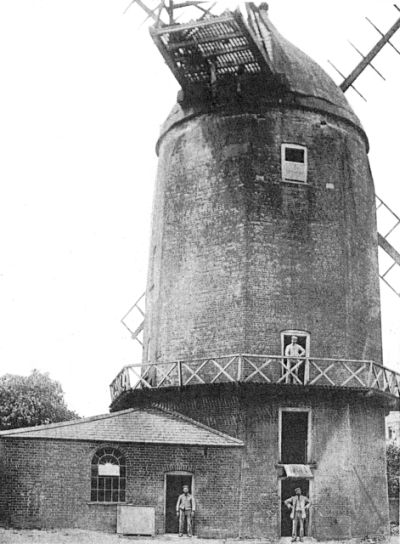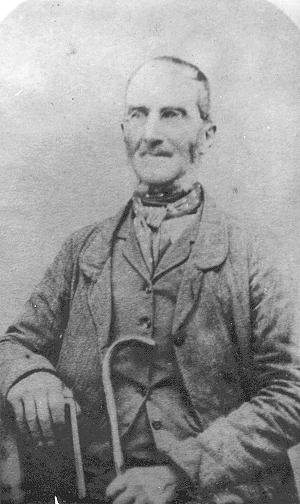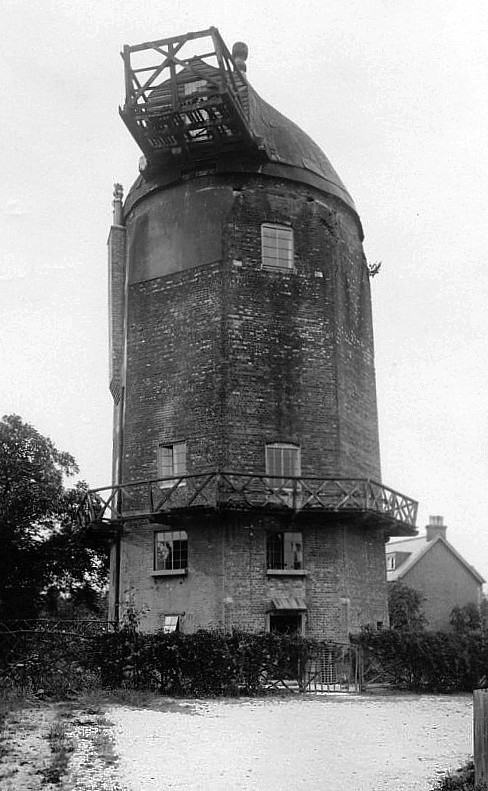|
Although the fan-stage and fantail are long gone, the worm-gear that
the fantail drove remains in place together with cross-bars to
permit hand-winding (fig. 10.3), necessary when there was a very sudden
change in wind direction. This gearing connects via a vertical
spindle with an iron rack of some 300 iron teeth. Set into the cill,
the rack extends around the circumference of the cap (plate 24).
The 30 iron rollers
upon which the cap revolved also remain in place, some being just visible
above the rack.

Fig. 10.3: hand winding gear
in the cap
The cap is of wood and much larger than those at Quainton, Goldfield
and Hawridge tower mills. Its base consists of four cross members
that are mortised at each end into two massive beams that extend
across the mill. Above this, 24 substantial rafters arch upwards to
a pinnacle, forming the frame that supports the roof — quite
spectacular as one looks up at its apex (plate 23). The roof’s
interior is clad with wooden boarding, its exterior with zinc
sheeting.
Notable among the mill’s former machinery were its upright shaft —
reported to have been a ship’s mast — and its 4-ton, 18ft iron
windshaft, which remains in place and which the millwright Derek
Ogden, who worked on the mill in the 1960s, claimed to be the
biggest that he had ever seen (plate 25). Also remaining and clearly
visible from behind the mill, is the iron centre cross on which the
stocks that carried the sails were mounted. Originally, the sails
were of the ‘simple’ variety but these were later replaced; when the
mill was sold in 1875, the auctioneer’s catalogue described them as
being . . . .
“of modern construction, with all the
latest improvements, two of which are recently new, and the Fan
[fantail] will be found good and
efficient.”
Although long gone in Freese’s time, he describes the sails as
having been “double-shuttered anti-clock patents”, which can be seen
at fig. 10.2.
The mill originally had a gallery at second floor level (fig. 10.4)
but this was removed in 1947 when extensive repairs were carried out.
The
present gallery at cap level (plate 22) is a recent addition, constructed to
ease roof maintenance, for leakage has been a recurring and expensive
problem to deal with. A tall chimney stack was also built onto the
south side of the mill at some time after windmilling ceased, for it
would otherwise have impeded the fan-stage as it revolved.
STEAM MILLING
|
 |
|
Fig. 10.4:
Wendover mill showing the engine house |
At some point in its life wind power was supplemented with a 12 hp
steam engine installed in an engine-house built onto the south side
of the mill . . . .
|
“. . . the former windmill at Wendover was converted to steam power
because the building of houses near to it affected the currents of
air. The late Mr. F. Purssell, the miller, said there was great
difficulty when the wind shifted suddenly into the opposite quarter,
and the sails started to revolve backwards. The sails had to be
wound round by hand to bring them into the wind again.”
In Buckinghamshire, G. Elland,
1923.
|
Stanley Freese describes the machinery as . . . .
|
“. . . . an exceptionally fine expansion engine, no doubt the best ever used
in a Buckinghamshire windmill . . . . starting from cold at 7.30
a.m., she would soon grind corn with about 40 lbs. of steam, but
would not operate the sack hoist until about 11.30 . . . . sometimes
the sack hoist was driven all day in order to replenish the
exceptionally capacious bins.” |
A flue from the engine’s boiler passed underground to a tall
brick-built chimney in the centre of the mill yard. Although it is
not known when the steam engine was installed, it is recorded that it
was by Hillsdons of Tring (Chapter V).
Milling is believed to have continued using both wind and steam, but
having been damaged severely by a storm the sails were removed in
1904.

Fig. 10.5: the miller’s house
THE MILLERS
|
 |
|
Fig. 10.6: Charles
Burton |
Wendover Mill had a number of occupiers up to 1875. Local trade
directories list Thomas Horwood and Thomas Andrews as millers in
1842 and 1850 respectively; the 1851 Census lists Charles Burton. In
1861 the diary of Thomas Grace of Tring records that he accompanied
his brother-in-law, Edward Mead, to look over the mill and that
Edward agreed to pay £100 a year in rent. Mead operated the mill
until 1869 when Thomas Edward Biggs took over.
In 1875, due to the expiry of the lease, the mill was offered for
sale by auction. The name Zachariah Phillips appears on the
auctioneer’s ground plan, which suggests that the freehold remained
in the possession of the original owners, the Phillips family. The
sale was conducted by Reader & Son at the Bell Hotel, Aylesbury. Their catalogue describes the property as a . .
. .
“Brick-built, octagon-shaped, roomy
FREEHOLD WINDMILL
of five stories, driving three pairs of stones,
with the whole of the gearing complete
also, attached thereto, a
12-HORSE-POWER STEAM ENGINE
and boiler, with high Shaft, driving two pairs of Stones . . . .”
In addition to the windmill were granary, store houses, cart sheds,
stables, the miller’s house, out-houses, yard and garden. The
catalogue goes on to describe in detail the mill’s structure and
equipment (see Appendix I).
The mill was bought by William Purssell for £1,000, but others ran
it for the names of Francis Beesley (1877) and George Butterfield
(1883) appear in the records. On William Purssell’s death in 1887,
his son Frank took over from Butterfield and continued to operate
the mill until his death in 1922.
In his account, Freese suggests that in its early life the windmill
was unsuccessful commercially and it was not until Frank Purssell’s
time that business began to look up . . . .
“. . . . he took her over from a Mr Butterfield. Steadily the
business improved under his management, and he confounded the
pessimists by building up a very flourishing and successful trade,
which was still very good when he passed away in 1922 . . . . mostly
English wheat was ground in the old days, some of it coming by canal
to Wendover Wharf, but with the steam engine they latterly ground
much Russian barley and American maize, etc. and flour was made
until about 1912; generally speaking there was a loss of about 7
lbs. per bushel.”
Following Frank’s death in 1922 his son Basil carried on, but by
then business was beginning to decline, probably due to competition
from larger and more efficient roller mills. By 1925 the mill was
only working two days a week due to “difficulties of the trade”. In
the following year, the General Strike and its coal shortage led to
the mill’s closure. The machinery was removed in 1929 and the engine
house and chimney were demolished two years later.
THE WINDMILL IN DOMESTIC LIFE

Fig. 10.7: the mill following
conversion to a dwelling c.1930
By the time of its closure, the mill’s floors were in poor
structural condition with rot affecting some of the joists, probably
due to damp seeping through flaws in the bonding of the brickwork. The mill’s cap was also perishing and there was talk of demolishing
the top two floors. This drastic action was avoided, and in
1931 the mill was converted to a private house. Freese, writing
during the 1930s, reports that . . . .
“. . . . some big long irons or bolts were inserted by which the
weak fourth floor is now practically suspended from the curb of the
mill, whilst the fifth floor has two iron girders set into the wall
just below, giving support to the rotten ends of the two main
joists. New staircases have been installed . . . . and the ground
floor has been converted to a cosy living room by Miss Marion
Fawcett, the actress and playwright, who is now the tenant, whilst
the second floor contains two comfortable bedrooms and a bathroom,
the upper floors being vacant .”
Miss Fawcett, who leased the mill for 15s. a week, continued the
tenant until 1946 when the mill again fell into disuse. Basil Purssell, writing to the
Bucks Herald in October 1954, stated that .
. . .
“In October 1948, when a gale blew in part of the back cap, Mr
Freese was a great help. Together with a London workman, Mr. Carew,
who had been working therein that summer, he repaired the roof
temporarily for £50 and it was a courageous job. . . . the late Mrs.
Frank Purssell planned the preservation of the mill back in 1931,
the idea being to convert it into a comfortable home . . . after
that considerable sums of money were spent on maintenance both by
the owners and the leaseholder, London actress Marion Fawcett.”
By 1953 the mill was again in a poor state of repair and at risk of
demolition. It was offered for sale and an advertisement in the
New
Statesman caught the eye of Kenneth and Margaret Roberton, who
bought the mill and moved in on Coronation Day, 1953. Again, the
Bucks Herald . . . .
“The new owner, who is the well-known musician Kenneth Roberton,
spent a further £600 this summer on renovation.”
The domed roof was rebuilt in the mid 1960s making the top two
floors habitable and from the 1970s until his death in 2003, Kenneth Roberton used them as the base for his music publishing business,
Roberton Publications. His obituary in the Bucks Herald stated that
he was a tireless campaigner for the town’s interests, helped to
found the Wendover Society, as well as fighting for the rights of
residents and battling against developments that he felt would
adversely affect the town.
A further piece of structural work on the cap is recorded in an
article on the mill in the Bucks Advertiser in June, 1971 . . . .
“in the summer of 1969, the familiar black cap was replaced with a
shining white aluminium one . . . .”
. . . . that the present occupier had to replace when the aluminium
was discovered to be leaking through its joints. The cap is now clad
with zinc sheeting, the fastenings of which are sheltered from the
rain by fold-over joints.
Today the windmill, which is Grade II listed, is a very comfortable
family home. Its five levels contain five bedrooms, three reception
rooms, three bathrooms and a kitchen (Appendix II) — but looking back at some of
the old repair bills, one cannot help forming the impression that
those who would live in an old windmill need a deep pocket!
――――♦――――
APPENDIX I.
AUCTIONEER’S PARTICULARS (1875)
ENGINE HOUSE
A superior 12-horse-power horizontal Steam Engine by Hillsdon,
Tring, working expansively with 11-inch cylinders, 2ft. 4ins stroke,
large fly wheel (11-feet diameter), steam and exhaust pipes, with
governors, pump, &c., bed plate, and brick foundation. An excellent
Cornish boiler (only recently put in), 18ft. by 4ft. 6ins, with flue
2ft. 3ins diameter, dome, safety valve, pressure gauge, water gauge,
and the brick setting thereof. Hand-force pump for feeding boiler.
THE MILL
GROUND FLOOR. — Crank shaft from steam engine, 5½-inch diameter, and
14ft. long, driving two pairs of wheat stones on first floor, on
cast-iron upright frames, with plummer blocks and brasses, carrying
two bevel wheels, driving pinions, on stone spindle, with iron
bridge-trees and brass steps, iron rising screws one drum on end of
shaft, for driving dressing tackle on 1st Floor two meal bins and
shoots, jogging screen for offals, sack jumper, and step ladder.
FIRST FLOOR. — Two pairs of 4ft. wheat stones (driven by steam power),
with damsels, wood hoppers and casing, stone spindles, bevel wheels
and pinions, iron shaft, driving pulley, cast-iron housings,
housings, and wood shoot. One 21-inch lay shaft, 9ft. 6ins long, with plummer blocks and three pulleys, driving the 3ft. 6ins dressing
machine, with 16-inch cylinder, pulleys, plummer blocks and shaft,
complete in deal case flour bin, offal bin.
SECOND FLOOR. ― Spur wheel and three stone nuts and spindles, bridge
trees, rising screws, and governors, three jogging screens to part
the offals, three meal bins, three spouts, apparatus and chain for
hoisting by steam power.
THIRD OR STONE FLOOR.
— Two pairs of wheat and one pair of barley
stones, 4ft. and 4ft. 6 in diameter, with damsels, wood hoppers, and
casings, stone spindles, spur wheels and pinions, iron shaft,
driving pulley, cast iron housings, and wood shoots one lay shaft,
about 10ft. long, with hanger and plummer blocks, bevel pinions for
driving smutter, dressing machine, and bolting mill one crown wheel,
on wallow shaft and iron pinion one dressing machine, 4ft. 6ins long,
with 16-inch cylinder, and apparatus feed, &c. one horizontal
smutting machine, 2ft. 2ins long, 16 inches diameter, with shaft,
pulleys, &c. bolting machine, 6ft. long, with spindle, pulley, plummer blocks, &c.
FOURTH FLOOR. — Hoppers to smut machine two others six large bins.
FIFTH STORY. — Iron wind shaft, with large iron boss and break wheel
cast iron wallow wheel, working into break wheel, with oak upright
shaft, circular rack, and hand-gear to fan-tail self-acting hoisting
tackle, with wood barrel break and lever, and about 84 feet of
quarter-inch chain.
YARD. — 53 feet of smoke flue, brick smoke shaft, base 6ft. square,
height about 55 feet. |